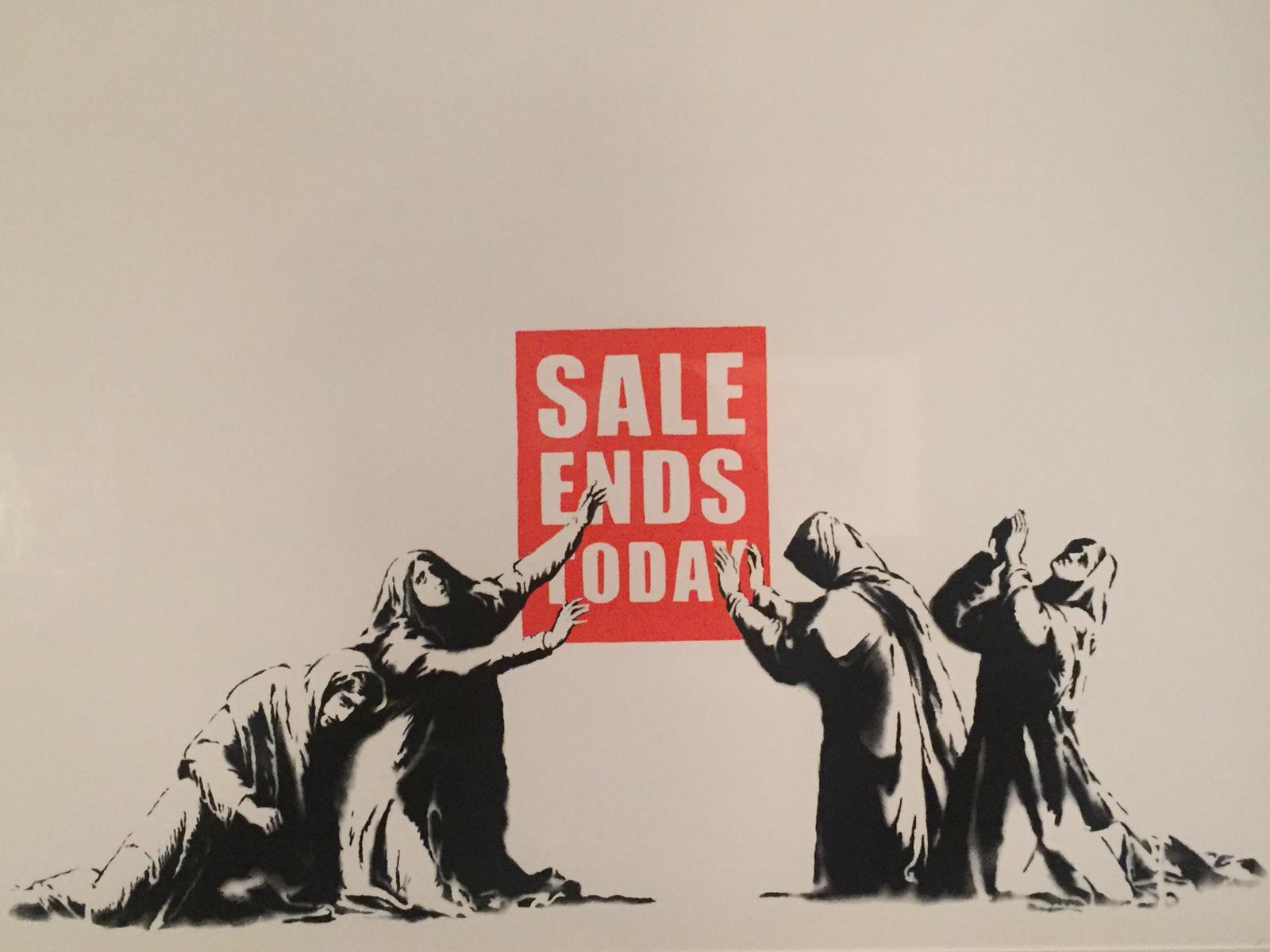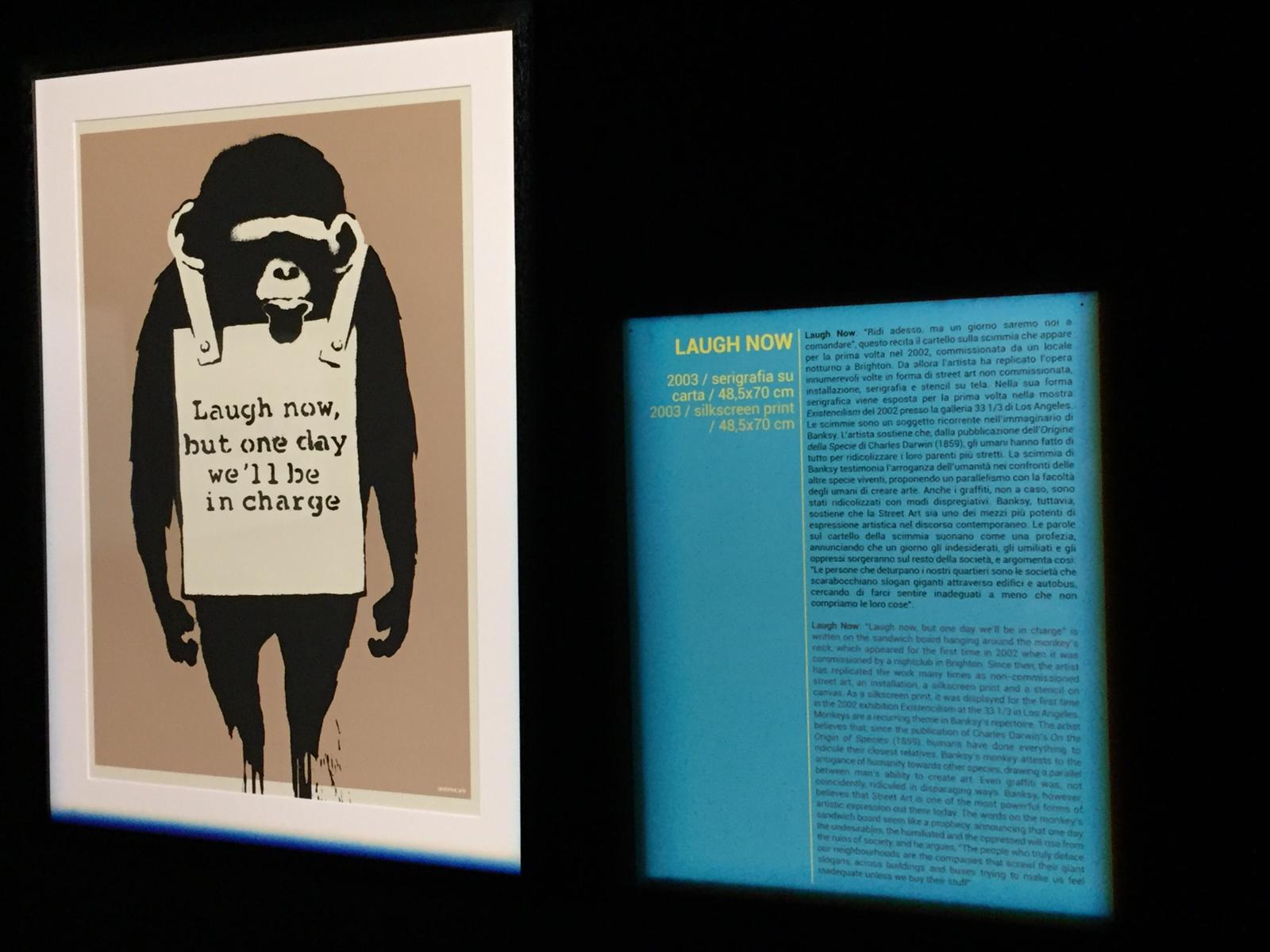
Palazzo Medici Riccardi, Florence
October 19, 2018 – February 24, 2019
The artist who goes beyond the limit… between play and provocation
by Anna Legnani (University of Florence)
There couldn’t have been a better moment! Every major newspaper has been talking about him after one of his works, Girl with a Balloon, self-destructed while being sold at auction by Sotheby’s for a million pounds. Now a selection of his best images, which have declared his worldwide success, are being displayed in Florence, in Palazzo Medici Riccardi, a unique and historically rich building.
We’re talking about Banksy, considered one of the most important figures in street art at the moment, who is introduced to the general public with the exhibition: “Banksy. This is not a photo opportunity” curated by Gianluca Marziani and Stefano S. Antonelli, open from the 19th of October to the 24th of February 2019.
From the main entrance on via Cavour, in a 15th century context, visitors enter the exhibition dedicated entirely to the great English artist and writer, whose identity remains unknown. The element of mystery increases and stimulates the contemporary public’s curiosity, overwhelmed by the immediate images, elementary and fun, but at the same time full of provocation and feeling.
Four small dark rooms display serigraphs of an artist who communicated, beginning with his murals, and then later with graphic-prints, a physical and psychological sign in cities all over the world. His works, in fact, are born in relation to the urban space in which he expresses himself and after starting in the mid-nineties on the walls and bridges of Bristol, the artist’s home city, Banksy broadened his horizons. His ‘urban frescos’, the artist’s preferred medium, have reached areas afflicted with conflict and war where other forms of protest and communication have struggled to arrive, like in the case of his mural on the long wall that separates the state of Israel.
Between 2002 and 2009 forty of his works were published and sold from his print house in London.
The visitor enters an evocative setting, with strong contrasts and bright colors, and slowly discovers the artist’s identity through his most famous graphics, the extensive explanatory texts and infographics of the artistic chronology, original posters from his exhibitions, and a selection of counterfeit videos and bank notes. Visitors can also examine the black books, small books published in the early 2000’s that contain a selection of images, aphorisms, poetry, and the artist’s reflections.
In contrast to the artist’s custom of creating of creating live works in a public setting, allowing visibility for everyone, the Palazzo Medici Riccardi exhibition does not connect the works in an urban context. The absolute contrast with Michelozzo’s meditated architecture is striking, and viewers are confronted with the contrast between the Renaissance courtyard, the contemporary context of the works, and their proposed layout.
The artist is controversial and complex, but compositionally extremely organized, and the using visual impact between images and cultural themes creates discussion and debate. The spectator is surprised by the union of craft production or industrial images that include and powerful sense of “british humor”, which the artist himself has baptized “brandalism”. Banksy, like a great magician, aims to create a “wow factor” in his works by including monkeys, mice, Mickey Mouse and Ronald McDonald, and military helicopters wrapped with bows. What at first glance seems to be only a great publicity-slogan instead hides a profoun message. In fact, the writer’s choices are all focused on visual protest. His works, through fusion of images and words, deal with universal arguments about politics, ethics, and mass culture.
He himself declares: “I like to think I have the guts to stand up anonymously in a western democracy and call for things no-one else believes in – like peace, justice and freedom”. There in lies his intent and polemic regarding the arrogance of the establishment and power, forced military intervention, homologation, pollution, consumerism and conformism of the Western matrix.
Moreover, as often reconfirmed by many scholars, Banksy represents the higher evolution of Pop Art, and is unique in his fusion of serial multiplication, hip hop culture, 1980’s style graffiti, and an approach distinctly from the digital age.
What is most evident in the Palazzo Medici exposition is how the great street artist is perfectly at home and active in contemporary society. Pushing himself to unimaginable limits, renewing his work, and inviting us to reflect on society and politics with his trademark touch of irony and challenge.
Translation by Marie-Claire Desjardin (Istituto Lorenzo de’ Medici)
Banksy – This is not a photo opportunity

Palazzo Medici Riccardi, Firenze
19 ottobre 2018 – 24 febbraio 2019
L’artista che va oltre il limite… tra gioco e provocazione
di Anna Legnani (Università degli studi di Firenze)
Momento migliore non poteva esserci! Ha fatto parlare di sé sulle maggiori testate del mondo dopo aver autodistrutto una sua opera, Girl with a Balloon, venduta ad un’asta di Sotheby’s per un milione di sterline. Ora una selezione delle migliori immagini, che hanno decretato il suo successo mondiale, viene esposta a Firenze, in un luogo unico e ricco di storia quale è Palazzo Medici-Riccardi.
Stiamo parlando di Banksy, considerato uno dei maggiori street artist del momento, che viene presentato al grande pubblico nella mostra: “Banksy. This is not a photo opportunity” a cura di Gianluca Marziani e Stefano S. Antonelli, visitabile dal 19 ottobre al 24 febbraio 2019.
Dall’ingresso principale di via Cavour, in un contesto quattrocentesco, si accede alla mostra interamente dedicata al grande artista e writer inglese, la cui identità è ancora sconosciuta. Questa aura di mistero incrementa e stuzzica ancora di più il pubblico moderno che si lascia sopraffare dalle sue immagini immediate, elementari e divertenti ma, allo stesso tempo, cariche di provocazioni e sentimento.
In quattro sale piccole e buie spiccano le serigrafie d’un grande artista che ha cercato, innanzitutto attraverso i suoi murales, successivamente anche in opere grafiche-stampe, di lasciare un segno fisico e psicologico nelle città di tutto il mondo. I suoi lavori, infatti, nascono in relazione con lo spazio urbano nel quale lui si esprime e dopo aver iniziato, a metà degli anni Novanta, dai muri e ponti di Bristol, città di origine dell’artista, Banksy ha allargato i suoi confini. I suoi “affreschi urbani”, il mezzo di comunicazione preferito dall’artista, raggiungono le zone di conflitto e guerra dove altri mezzi di protesta e comunicazione fanno fatica ad arrivare come è avvenuto sul lungo muro che separa lo stato di Israele.
Tra il 2002 e il 2009 vengono pubblicate su carta, vendute tramite la sua print house a Londra, quaranta delle sue opere.
Il visitatore in un suggestivo allestimento, dai colori forti e accesi, scopre piano piano l’identità dell’artista attraverso la visione dei suoi interventi grafici più famosi, la lettura delle ampie schede esplicative e dell’infografica sulla cronologia artistica, la visione dei poster originali delle sue mostre, di una selezione di video e di banconote contraffatte. Il visitatore può inoltre conoscere i black books, piccoli libri pubblicati ad inizio duemila che raccolgono una selezione di immagini, aforismi, poesie e riflessioni del writer.
In contrasto con la consuetudine dell’artista che rende vive le sue creazioni inserendole nel contesto cittadino, ponendole accessibili e visibili a tutti, nell’esposizione a Palazzo Medici Riccardi il contatto con lo spazio espositivo ed urbano non si percepisce. Vige il contrasto assoluto con l’architettura meditata di Michelozzo e si rimane positivamente stupiti della forte opposizione tra il cortile rinascimentale e il contesto contemporaneo delle opere e dell’allestimento proposto.
Autore controverso e complesso ma estremamente ordinato nella capacità compositiva, nell’impatto segnico ribalta l’immagine e i temi culturali creando discussione e dibattito. Lo spettatore è sorpreso dal connubio di rappresentazioni di produzione artigianale o di immagini industriali con un nascosto ma allo stesso tempo potente british humor, che lo stesso artista ha battezzato con il nome di “brandalism”. Banksy, come un grande mago, vuole puntare a creare un “effetto wow” dell’immagine inserendo nelle sue produzioni scimmie, topolini, Mickey mouse e McDonald, elicotteri da guerra abbelliti con fiocchi. Quello che ad un primo sguardo sembra solamente una grande pubblicità-slogan, nasconde invece un profondo messaggio, infatti, le scelte del writer sono tutte incentrate in una protesta visiva. Le sue opere, attraverso fusione di immagini e parole, trattano argomenti universali quali la politica, l’etica, la cultura di massa.
Lui stesso dichiara: “Mi piace pensare di avere il fegato di far sentire la mia voce in forma anonima in una democrazia occidentale ed esigere cose in cui nessun altro crede come la pace, la giustizia e la libertà”. Egli manifesta tutto il suo intento e la sua polemica riguardo all’arroganza dell’establishment e del potere, della guerra e dell’intervento forzato militare, dell’omologazione, dell’inquinamento, del consumismo e conformismo di matrice occidentale.
Inoltre, come spesso ribadito da molti studiosi, Banksy rappresenta la miglior evoluzione della Pop Art originaria, l’unico che ha fuso assieme la moltiplicazione seriale, la cultura hip hop, il graffitismo anni Ottanta e gli approcci del tempo digitale.
Quello che più emerge nell’esposizione di Palazzo Medici è come il grande street artist sia perfettamente inserito e attivo nella società contemporanea, spingendosi oltre i limiti inimmaginabili, aggiornando la sua produzione e invitandoci a riflettere sulla società, sulla politica sempre con quel pizzico di ironia e sfida.
Video produced by the Istituto Lorenzo de’ Medici
Photo courtesy Anna Legnani